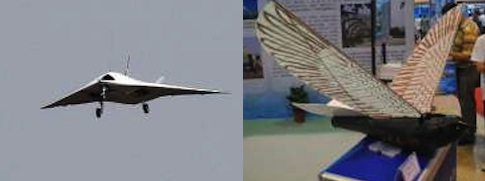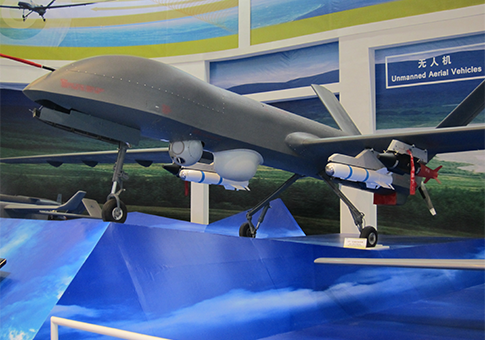China’s military is expanding its unmanned aerial vehicle forces with a new Predator-like armed drone and a new unmanned combat aircraft amid growing tensions with neighbors in Asia, according to U.S. intelligence officials.
New unarmed drone deployments include the recent stationing of reconnaissance and ocean surveillance drones in Northeast Asia near Japan and the Senkaku islands and along China’s southern coast. Drones also are planned for the South China Sea where China has been encroaching on international waters and bullying nations of that region in asserting control over international waters, said officials familiar with intelligence reports.
"Unmanned aerial vehicles are emerging as critical enablers for PLA long range precision strike operations," said Mark Stokes, a former military intelligence official now with the Project 2049 Institute. "A general operational PLA requirement appears to be persistent surveillance of fixed and moving targets out to 3,000 kilometers of Chinese shores."
Japan, meanwhile, is developing and purchasing military drone capabilities to counter what it regards as Chinese aggression and Beijing’s growing military capabilities as Tokyo’s dispute with China over the Senkaku islands intensifies, the officials said.
After Chinese aircraft intruded into Japanese airspace over the Senkakus undetected late last year, Tokyo stepped up efforts to seek drone capabilities. The efforts include building an indigenous missile-tracking drone and high-altitude U.S. drones.
So far, unlike Beijing, Tokyo asserts its drone will be unarmed, the officials said.
"China has started deploying UAVs for reconnaissance and oceanic surveillance purposes in the vicinity of disputed maritime territories, such as the Senkaku Islands," said one military source.
Of particular concern to U.S. intelligence agencies are two new missile-equipped drones known as the CH-4 and Yi Long. The aircraft were shown off along with six other military drones at a major Chinese arms show last November in Zhuhai.
Photos of the drones reveal the designs appear to be copied from the U.S. Predator armed drone that has been leading the Obama administration’s war on al Qaeda in Pakistan and elsewhere. Photos of the CH-4 show it armed with Blue Arrow-7 anti-tank missiles that appear similar in size to the U.S. Hellfire fired from Predators.
Even more of a concern, according to the officials, are intelligence reports from Asia indicating that China is well along in building a large stealth unmanned combat aerial vehicle (UCAV)—an upiloted jet—that was revealed recently in an online Chinese military video.
The drone combat jet is nearly identical in shape to the experimental batwing-shaped U.S. Air Force X-47B currently under development. The X-47B was tested on an aircraft carrier in December.
The Chinese UCAV is expected to have enough range to reach the U.S. island of Guam, some 1,800 miles from the Chinese coast and the hub of the Pentagon’s shift to Asia, officials said.
Video and photos of the Chinese UCAV were posted on Chinese military enthusiast Internet sites recently. Also, a model of the drone combat jet was on display at Zhuhai. The aircraft is being built by the China Shenyang Aerospace Institute and could be deployed on China’s new aircraft carrier, officials said.
Richard Fisher, a China military analyst with the International Assessment and Strategy Center, said the first prototype flying wing UCAV was completed at China’s Hongdu Aircraft Corp in mid-December. The drone weighs 10 to 14 tons and could be carrier based.
"This means that the U.S. attempt to ‘outrange’ an emergent PLA anti-access systems, like the DF-21D anti-ship ballistic missile, could soon be outflanked by a new PLA carrier-based UCAV," Fisher said.
Japan, alarmed at fierce Chinese reaction to its efforts to solve the Senkakus dispute by nationalizing several of the uninhabited but oil-rich islands last year, is bolstering its military forces with both missile-detecting and maritime surveillance with drones.
Japanese Defense Ministry officials, quoted in press reports, have called the purchase of several long-range U.S. Global Hawk surveillance drones an urgent priority.
Tokyo is seeking up to three Global Hawks by 2015 but could speed up purchases in response to what it regards as growing Chinese aggressiveness toward Japan over the Senkakus.
The U.S. military currently has Global Hawks deployed at Guam.
The Japanese do not plan to develop armed drones and plan to limit initial purchases to the Global Hawk, which fly nearly 60,000 feet for extended missions. It is able to track vessels using sensors and radar.
Japan also is developing an unmanned drone aircraft that will be used to detect North Korean nuclear missile attacks and to counter the Chinese military buildup, the officials said.
The anti-missile drone program is being developed over the next four years with the first drone deployed by 2020. It will use infrared sensors designed to detect missiles shortly after launch.
China’s drone program is believed to have benefitted from its aggressive economic and cyber espionage operations against the United States. Those efforts have included breaking into both government and defense industry networks and stealing valuable drone technology.
Officials also said China’s drone program is receiving a boost from an unlikely source: Taiwan.
The largest Chinese drone production center is being built at Wuhan in Hubei province, site of a joint construction project by China’s Wuhan Visiontek Inc. and Taiwan’s Carbon-Based Technology, Inc.
Officials said China launched a crash program to develop military drones beginning around 2007. Beijing is planning a range of unmanned aircraft capabilities, including high-altitude, long-endurance drones, integrated air and sea warfare drones, sea-based drones and UCAVs.

More than 60 drones were on display in Beijing last June, including a drone helicopter, and a drone with simulated birds’ wings.
Additionally, officials have said drone bases are being set up in the South China Sea to monitor Scarborough reef, which is claimed by Philippines and China; Macclesfield Bank; the Paracel Islands; and the Spratly Islands. China also is using drone to monitor the Socotra Reef claimed by South Korea.
A report made public March 11 by the Project 2049 Institute on Chinese drones estimated that China has more than 280 military drones.
"The PLA has developed one of the largest and most organizationally complex UAV programs in the world," the report stated.
For the immediate future, the Chinese drones are monitoring disputed maritime and land boundaries that are likely to "increase tensions" since other states in the region lack the same capabilities.
"Like any new capability, UAVs may encourage the inexperienced to overreach and engage in risk taking," the report said. "There could be a sense that because human pilot lives are not at stake, operators can push farther than they otherwise might."
An isolated UAV attack during a crisis also could lead to a major conflict. "In the future, PRC decision-makers might feel compelled to order ‘plausibly deniable’ UAV attacks as a means of sending a political signal only to inadvertently wind up escalating tensions," the report said.
Over the long term, Chinese drones will support the expansion of Chinese military operational areas by pushing the ability to hit targets further into the western Pacific. The report said China likely will use its UAV force for targeting and guidance of the DF-21D anti-ship ballistic missile designed to strike U.S. aircraft carriers more than a thousand miles from China’s coast.
"While the potential for a large scale conflict in the region currently appears low, the lack of adequate preparation for worst case scenarios could encourage and invite adventurous adversary behavior, ultimately increasing risks to peace and stability," the report stated.
U.S. intelligence agencies reported earlier this month that China plans to build 11 drone bases along its coastline by 2015, with each base deploying at least one unmanned aircraft.
The People’s Liberation Army currently has two drone bases in northeast Liaoning province. A third base was disclosed further south at Lianyungang, Jiangsu Province, also on the Bohai Sea.
The bases were announced in August by the State Oceanic Administration, which has been used as a proxy by the Chinese military to lay claim to international waters and islands as part of a strategy of pushing Chinese maritime control hundreds and eventually thousands of miles from the coast through what Beijing calls its two Asian island chain strategy. The island chains stretch from Northeast Asia through Southeast Asia.
The two bases in the Bohai Sea are located at Yingkou and Dalian to provide surveillance of the Bohai and Yellow Seas.
China called U.S. aircraft carrier exercises held in the Yellow Sea three years ago "a threat to China" even though the carrier maneuvers were carried out in international waters.
The maritime surveillance drones provide high-definition remote imagery and will be used by China to respond to emergencies in the region and also to identify what China claims are illegal resource extraction from undersea gas and oil deposits.
U.S. officials regard recent highlighting of attack drones as a sign that Beijing remains intent on taking control of the Senkakus.
The increased use of drones by both China and Japan is expected to increase tensions over the Senkakus, the officials said.
According to Fisher, China is also exporting two of its armed drones, the Yi Long and CH-3, to the United Arab Emirates and Pakistan.
The UAE government purchased the Yi Long, and a smaller CH-3 was sold to Pakistan and repackaged by Islamabad as the Shahpar.
Fisher said he is concerned China will sell the new and larger CH-4 to Iran.
"Because it is not connected to the Aviation Industries Corporation (AVIC) which wants to do business in the United States, the CH-4 stands a better chance of being sold to Iran," he told the Free Beacon.
"China's willingness to sell UCAV technology to terrorist-linked states means that terrorists may soon have another deadly tool with which to attack the United States."
